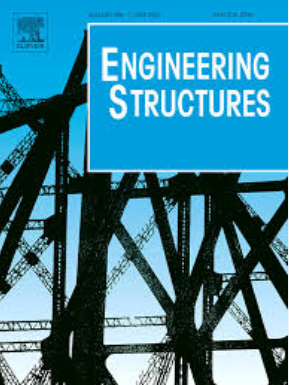Integrated multiscale topology optimization of frame structures for minimizing compliance
IF 5.6
1区 工程技术
Q1 ENGINEERING, CIVIL
引用次数: 0
Abstract
Frame structures are widely used in aerospace and other engineering fields due to their efficient provision of structural stiffness with minimal material usage. Recent advances in manufacturing technologies, such as 3D printing, have made it feasible to fabricate multiscale structures with complex microstructures, enabling further weight reduction. To fully exploit the design space of multiscale frame structures while circumventing the prohibitive computational costs in conventional solid-element-based direct numerical simulations, this paper proposes an Integrated Multiscale Topology Optimization (IMTO) method for frame structures. The method aims to minimize structural compliance by simultaneously optimizing both the macroscale (topological connectivity of the frame geometry) and microscale (material distribution within Representative Volume Elements, RVEs) in a unified framework. The macro- and micro-scale design variables are simultaneously embedded in the compliance formulation while the sensitivity analysis is systematically computed via the chain rule to unify the multiscale optimization into a single-scale framework. Compared to concurrent multiscale approaches, this strategy not only achieves computational efficiency with a single optimization loop, but also allows adaptive volume fraction allocation across RVEs. Numerical examples demonstrate the importance of considering shear deformation effects in the topology optimization of frame structures, and also validate the feasibility of the method for performing multiscale topology optimization design of large-scale frame structures in engineering applications.
基于柔度最小化的框架结构集成多尺度拓扑优化
框架结构以最小的材料用量有效地提供结构刚度,在航空航天和其他工程领域得到了广泛的应用。3D打印等制造技术的最新进展使得制造具有复杂微结构的多尺度结构成为可能,从而进一步减轻了重量。为了充分利用多尺度框架结构的设计空间,同时规避传统基于实体单元的直接数值模拟的高昂计算成本,本文提出了一种框架结构的集成多尺度拓扑优化(IMTO)方法。该方法旨在通过在统一的框架中同时优化宏观尺度(框架几何形状的拓扑连通性)和微观尺度(代表性体积单元内的材料分布)来最小化结构顺应性。在柔度公式中同时嵌入宏观和微观尺度的设计变量,并通过链式法则系统地计算灵敏度分析,将多尺度优化统一到单尺度框架中。与并行多尺度方法相比,该策略不仅实现了单个优化循环的计算效率,而且允许跨rve的自适应体积分数分配。数值算例表明了在框架结构拓扑优化中考虑剪切变形效应的重要性,也验证了该方法在工程应用中进行大型框架结构多尺度拓扑优化设计的可行性。
本文章由计算机程序翻译,如有差异,请以英文原文为准。
求助全文
约1分钟内获得全文
求助全文
来源期刊

Engineering Structures
工程技术-工程:土木
CiteScore
10.20
自引率
14.50%
发文量
1385
审稿时长
67 days
期刊介绍:
Engineering Structures provides a forum for a broad blend of scientific and technical papers to reflect the evolving needs of the structural engineering and structural mechanics communities. Particularly welcome are contributions dealing with applications of structural engineering and mechanics principles in all areas of technology. The journal aspires to a broad and integrated coverage of the effects of dynamic loadings and of the modelling techniques whereby the structural response to these loadings may be computed.
The scope of Engineering Structures encompasses, but is not restricted to, the following areas: infrastructure engineering; earthquake engineering; structure-fluid-soil interaction; wind engineering; fire engineering; blast engineering; structural reliability/stability; life assessment/integrity; structural health monitoring; multi-hazard engineering; structural dynamics; optimization; expert systems; experimental modelling; performance-based design; multiscale analysis; value engineering.
Topics of interest include: tall buildings; innovative structures; environmentally responsive structures; bridges; stadiums; commercial and public buildings; transmission towers; television and telecommunication masts; foldable structures; cooling towers; plates and shells; suspension structures; protective structures; smart structures; nuclear reactors; dams; pressure vessels; pipelines; tunnels.
Engineering Structures also publishes review articles, short communications and discussions, book reviews, and a diary on international events related to any aspect of structural engineering.
 求助内容:
求助内容: 应助结果提醒方式:
应助结果提醒方式:


